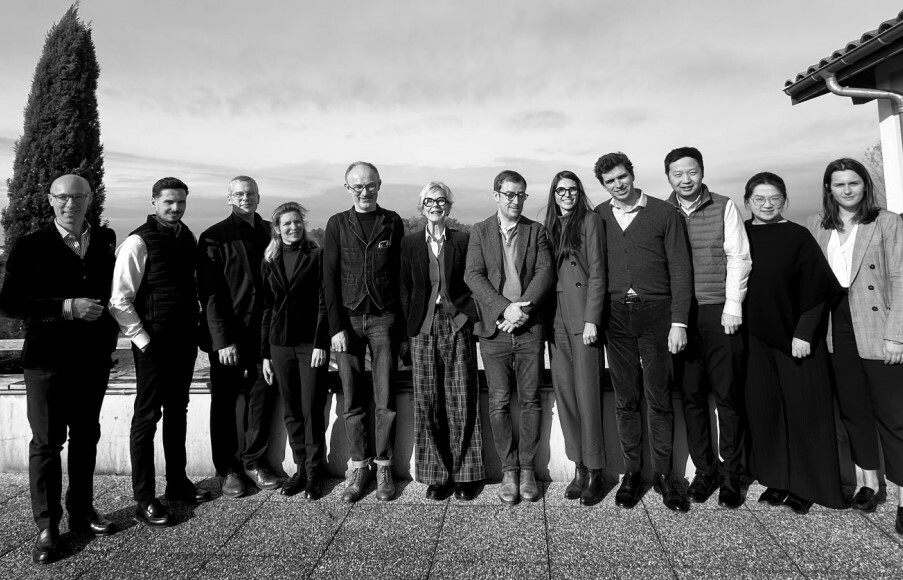Come and Taste Ausone Wines on our stand at
Wine Paris – Hall 7.1 – E001
from February 10 to 12, 2025
 We are offering the Inside in an audio file
We are offering the Inside in an audio file
We organized our second “Regards Croisés” session around the magnificent wines of Vignobles Vauthier, with the participation of Edouard Vauthier (co-owner), Antoine Gimbert (Commercial Director), Colin Hay (professor at Sciences Po Paris and Bordeaux Correspondent for The Drinks Business), and the Roland Coiffe commercial team.
In the “Inside” feature of May 17, 2023: Inside La Place : The ascent to Château Ausone… 5 gems from the Vauthier family, Edouard explained : “Châteaux Simard, Fonbel, and Haut-Simard fall under the Village appellation, Château Moulin-Saint-Georges and La Clotte are Premiers Crus, and Château Ausone is a Grand Cru. I love this comparison with Burgundy because we embody the spirit of a family of owners who know how to craft wine ourselves, without following trends! We aim to offer a range of wines for every consumer, with true identity and genuine family expertise spanning 11 generations. We must showcase the captivating complexity of our seven crus.
As for Colin Hay, I really enjoy talking with him. He is not only one of the wine critics with a deep knowledge of Bordeaux wines but also a keen analyst of the economic landscape of La Place de Bordeaux. He aptly remarked during this conversation: “Bordeaux has all the ingredients to succeed even in difficult market conditions.”
In the “Inside” feature of August 18, 2022, Inside La Place : Message in a bottle Colin said :“I want to understand more than I want to critique. I don’t consider myself a critic; I see myself more as a commentator and correspondent. My role is to understand and to share that understanding with my readers. I try to speak with owners, winemakers, and consultants as much as possible to better understand their wines. »
This “Shared Perspectives” with Colin Hay will be published in two parts: the first will focus on our discussion about the wines we tasted, while the second part will delve into our thoughts on the current and future outlook of the Bordeaux wine market.
Let me first take you on an exploration of the intricacies of Vauthier wines…
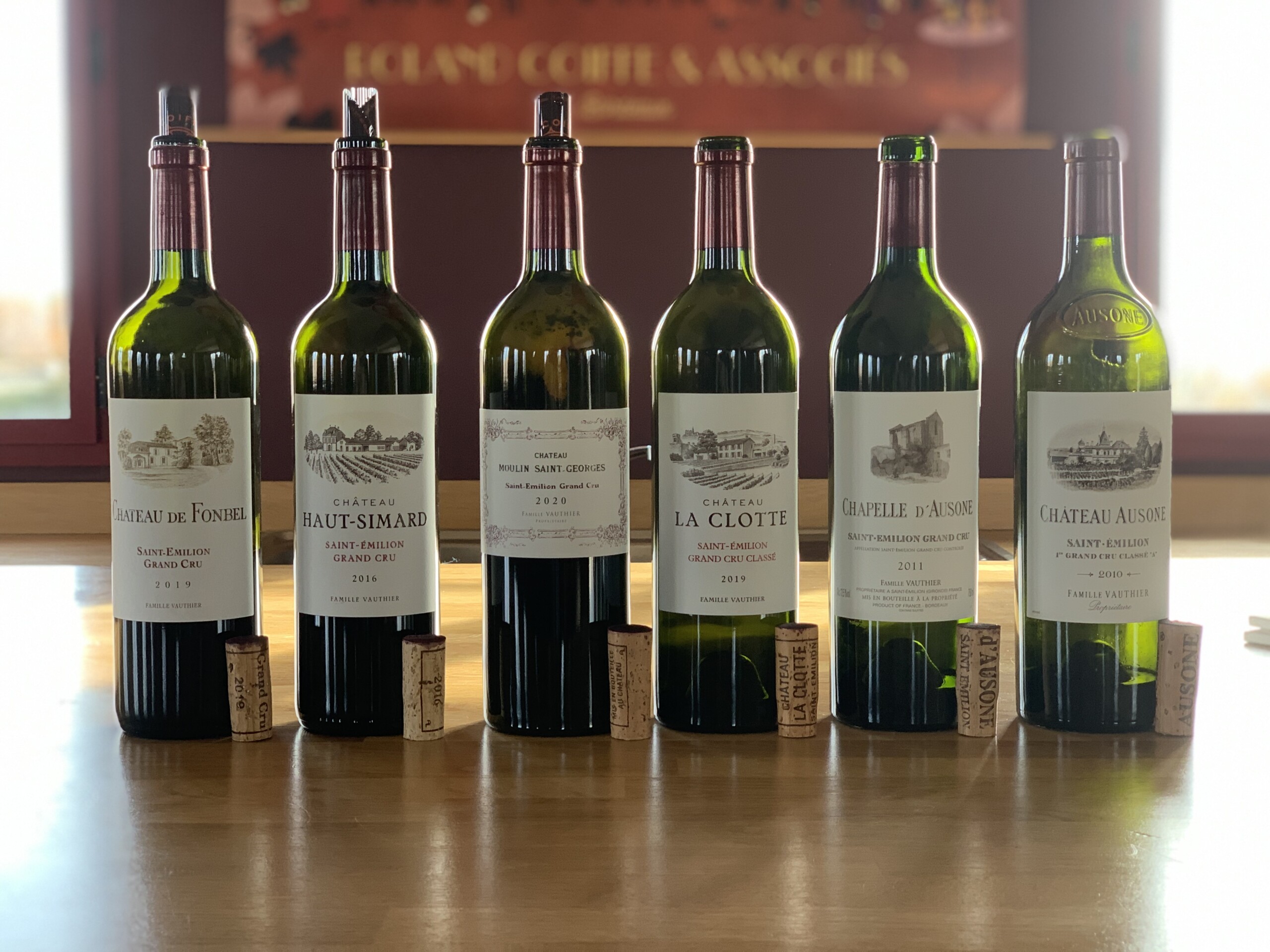
Tasting Highlights
Château Fonbel 2019: Elegant and delicate, with beautiful brightness. The blend, featuring 10% Cabernet Sauvignon and 5% Carmenère, adds complexity and tension.
Château Haut-Simard 2016: A more fluid and streamlined wine, with 35% Cabernet Franc contributing floral and spicy notes.
Château Moulin Saint-Georges 2020: Considered the revelation of the tasting. “It has lightness, vivacity, energy, and an almost astonishing crystalline brightness,” says Colin Hay.
Château La Clotte 2019: A balanced and harmonious wine with a strong limestone structure. “It could only come from this specific place,” notes Colin Hay.
Chapelle d’Ausone 2011: A vintage that is beginning to soften, showing the positive evolution of Vauthier wines.
Château Ausone 2010: The pinnacle of the tasting. An exceptional, lively wine that evolves constantly in the glass. “It is a beautifully guided wine, even though it has significant tannins,” describes Colin Hay
Gerda: What is your general impression about the wines of Vignobles Vauthier? Do you think there is a style “Vauthier”?
Colin Hay: Yes, I think that there is a Vauthier ‘style’, but it’s subtle. It’s a kind of homage to the Saint Emilion terroir and to its diversity. In fact, when we tasted the 6 wines, with Ausone the last to the tasted, we were climbing up from the bottom of the Côtes towards the plateau of Saint Emilion itself. We were seeing how the terroir changes. Essentially the Vauthier Style is to express terroir in the context of the vintage. Terroir is vintage specific. As we go towards the summit to La Clotte and Ausone, we are building the proportion of limestone which enhances the shape and the form of the tannins. The Vauthier Style is to respect that terroir. It reflects also the work in the vineyard to express the fruit as purely as it arrives in the winemaking facility.
G: The first wine we tasted was the Fonbel 2019. What do you think about the wine?
CH: I loved it actually. I think Fonbel is sometimes not as closely associated with Vauthier as it might be, but it is a fabulous wine as here in 2019. For me it is a wine that really expresses the vintage.
G: For me, it is an appealing wine, isn’t it?
CH: Yes, it is delightfully elegant. It is delicate in a way but is has a luminous clarity to it, a bright and crystalline character. We find that in some of the other Vauthier wines too. Indeed, it is something of a signature, which is reinforced by the vintage itself – 2019 – a lighter more delicate kind of vintage. This is a very harmonious wine. I loved it. It has a gentle sweet spiciness on the mid-palate which I really like, a little touch of graphite, a little bit of cedar as your breath in the air. It is al dente with just a little trace of tannin on the finish. It is great for drinking now.
G: There is a little touch of cabernet sauvignon, 10%, in the wine and Edouard strongly believes in this grape variety at Fonbel. Do you agree with him?
CH: Yes, particularly because there is also 5% of carménère in the wine. I think in a way the cabernet sauvignon together with the carménère produce something like a little cabernet franc-like. My tasting notes pick out peppercorns and that pepperness could either come from the cabernet sauvignon or from the carménère. But I suspect it comes from the combination of the two. The form of the wine is merlot but it has quite a lof of interest that comes from the combination of the grape varieties. There’s a delightful tension between them as they converse in the glass.
G: We are spoilt by Edouard, who let us taste great vintages. Between the trilogy 2018, 2019 and 2020, do you have a preference of one of those vintages?
CH: Yes, I do, my preference is probably for 2020. It is just sublime. It has everything you want I think, here in particular chez Vauthier. It has a certain luminosity and clarity and that crystalline character that you can also find in the 2019, as I said before. But it has more density, more concentration with more layers, more complexity and more aging capacity. I think 2020 is for me the peak of this trilogy. 2018 in Saint Emilion (even if not necessarily for the wines of Vauthier) can be just a little bit too much for me, a little bit too dense. It is very difficult to maintain that freshness in those wines. There is a big article, in which I compare 120 Saint Emilions (https://www.thedrinksbusiness.com/2021/03/bordeaux-2018-vintage-report-saint-emilion/) . There is freshness here. You do find it, above all on the plateau, on pure limestone terroirs above all. But 2018 is probably still the least favourite of the trilogy for me. The vintage 2019, I like and I rather like the way international critics seem to like it too as, in a way, it’s quite a subtle vintage. 2019 is appreciated by everyone, but is not quite at the level of 2020 for me.
G: The following wine of Vignobles Vauthier was Haut Simard 2016, which is also an exceptional vintage in Bordeaux. What do you think of this wine which has 35% of cabernet franc in its blend?
CH: I have always liked Haut Simard. It is very different from Fonbel in many ways, which is ampler, spicier and sweeter. It doesn’t have so much Szechuan peppercorn notes. It has a more traditional kind of spice box here. That said, it really evolves over the palate. On the entry and as the wine opens, it is very merlot. But with a little bit more aeration, the 35% cabernet franc starts to show through. I pick up fresh notes of aniseed, there is also a delicate florality which is really lovely. It is very expressive aromatically and you expect a wine which is ampler in the mouth than it is in fact is. It has a kind of natural restraint, tamed a little by its tannins. I rather like that. The effect is to render it more sleek and slender in the mouth more than you might expect.
G: Yes indeed. The wine has a beautiful bouquet and you expect something ampler and a larger structure in the mouth, but on the palate, it is quite vertical with as the finish as well.
CH: : Yes, I fully agree with that. It doesn’t have the density on the mid-palate like some of the other wines we have tasted. But it has a charm and a finesse which I really love. And frankly, a wine from St Emilion with 35% Cabernet Franc ,I am almost always going to love that!
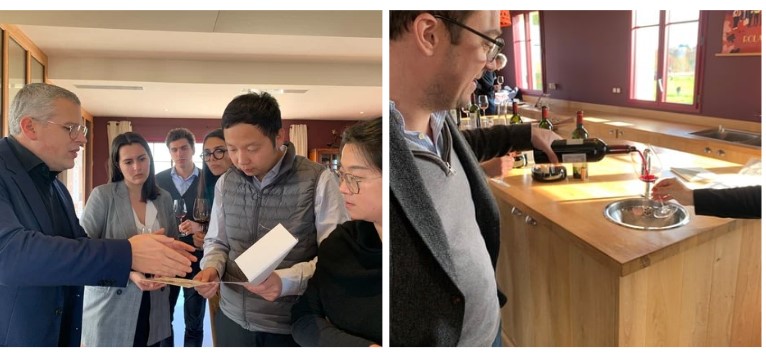 G: Do you think we should plant more cabernet franc in Bordeaux?
G: Do you think we should plant more cabernet franc in Bordeaux?
CH: I think when we can it’s a good thing to do. There is more Cabernet Franc today and there will be more Cabernet Franc in the future ; and that’s a good thing, above all with global climate change on terroirs like Haut-Simard. But it’s not a panacea and it needs to be planted in the right place. It is not a substitute for Merlot.
And whilst I love to see Cabernet Franc in a blend, it is the balance that we are looking for. A little can go quite a long way. In Haut Simard 2016 the blend of 65% merlot and 35% cabernet franc seem about right to me. There is a certain kind of amplitude which comes from the merlot, but this is not the biggest wine here in the mouth and I think, with less Merlot here, we’re have a more slender wine. The 2016 has an excellent balance, the two varietals very happy in each other’s company.
G: There is a very high planting density at Haut Simard, with some parcels having 12,600 plants per hectare. Edouard told us that this is because there is quite a lot of water in some areas.
CH: Yes, and I think that the high density of plantation will help in the future because the root system is very profound. The vines will find the water they need.
G: Some Classified Growths, and even a First, are considering decreasing the density of plantation.
CH: Yes, but this is very much a question of terroir. There aren’t general solutions here. The terroirs are rather different in the Médoc, and so the implications of climate change are a little different when it comes to hydric stress and, above all, how one might manage it. It is the same type of reflexion producing different forms of adaptation on different terroirs.
G: Do you think that 2016 is one of the best vintages, ever made in Bordeaux?
CH: Undoubtedly, yes. 2016 is close to perfection for me! I am very much a 2016 fan when it comes to 2015 versus 2016. For me, 2016 and 2010 go together in a sense because they are slightly more austere, slightly more slowly evolving than 2009 and 2015, particularly 2015, which is a very sunny vintage. I love my Bordeaux vintages to be classic, a little more serious, a little more introvert in a way. 2016 and 2010 are both “coups de coeurs”.
G: The next wine was Moulin Saint Georges 2020, which was wonderful.
CH: I don’t think I have ever tasted a Moulin Saint Georges that I have loved that much as this (though I recently tasted the exquisite 2010 and would highly recommend that too). I had a look at my en primeur tasting notes for the 2020. It really stood out at the time for me as well and was quite a revelation. It reminds us, I think, of two important things: the first, how good this terroir is and, the second, how we have tended to underestimate and underappreciate this wine.
G: Yes, we don’t speak enough about it. That one of the reasons we organise these sessions of Regards Croisés: to put the spotlight also on some hidden gems.
CH: It’s a property that I have always loved and re-tasting it today reminds me of when I first purchased it. It was always a Wine Society wine in Britain, a bit of an insider’s secret and it always seemed like very good value. It comes from a great terroir, it is very well made and yet never very expensive. That was true then, and it remains the case today as well. It is something of sleeping giant – a fantastically well-made wine with an outstanding rapport quality/prix, especially in 2020. The wine has all you could expect from it and more. It has density and concentration. It has lift, vivacity and energy. It has a beguiling grace and a luminous clarity which is almost startling. I am very excited by it. It also has a lovely limestone minerality. We have moved up the valley here are we are getting to parts where you find more and more limestone. You can feel that in the very structure of this wine.
G: All the wines were great but this wine surprised me the most.
CH: Yes, in part because of the vintage I think. 2020 is special. The connoisseur knows that at Moulin Saint Georges the Vauthiers are making great wines, but the vintage plays a key role here too. It lifts this above all reasonable expectations.
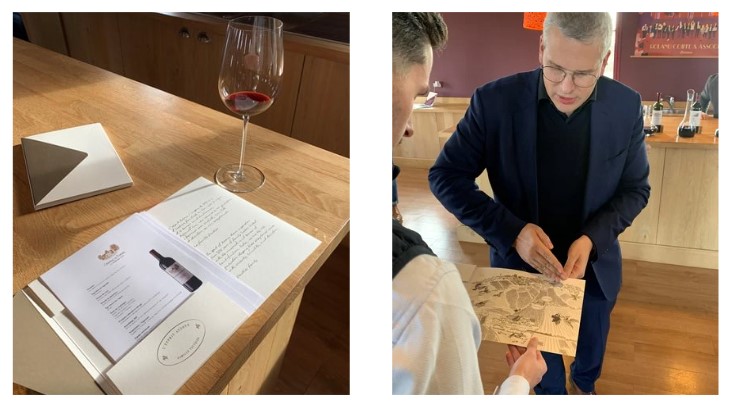
G: Now, the property the family bought in 2014, La Clotte 2019.
CH: This is another wine to make the heart beat faster – and, again, not as well-known as it deserves to be.
G: Could this issue stem from the fact that the estate is quite small, with just 4 hectares in total and only 2.4 hectares currently under production?
CH: Well, you just need a map! If you know what this is, where it is situated, you know immediately the quality of the terroir, and above all, if you taste the wine over a number of vintages, you can’t help but notice that this is an exceptional wine. It deserves to be an icon of Saint Emilion. But it is a name that even quite a few genuine lovers of Saint Emilion don’t really yet know. They will in time. Because there is little doubt in my mind that it will continue to receive fabulous tasting notes and scores from the critics. It is wonderfully made and it comes from a great terroir. It is also precisely the kind of terroir that I like the most. It is a combination of clay and limestone. The clay brings a certain puissance. There is a density in the mid-palate which is impressive but it is hyper-structured by those crumbly, chalky limestone tannins. That gives to this a kind of precision and a singular identity in the mouth, which works so very well with the density. The 2019 vintage has 10% cabernet sauvignon and 5% cabernet franc; that proportion is still rising in the vineyard. We have a lovely florality and that signature limestone salinity. That contributes to the sense of structure and to the juicy sapidity and salinity on the finish, imparting great length too. You know where you are with a wine like this. It can’t come from anywhere else. I really love that. It is not a wine which has too much of everything. It is a simple question of balance and harmony.
G: Yes, I do agree. At no point does the wine go over the edge.
CH: This is also related to the vintage. 2019 is everything in moderation, there is not too much of anything. That said, I have very fond memories of the 2015, which is a very different kind of vintage. It is a more sunny and opulent kind of vintage – ‘solaire’ as the French say. But even in 2015 the limestone reins it in. It gives the wine structure and freshness. But, ultimately, I prefer this vintage, the 2019. Probably it is also because the Vauthier family has had the vineyard a little bit longer by the time we get to 2019. They are imparting their style, their touch. 2015 was just the beginning. But 2019 is also a vintage which makes this kind of terroir shine.
G: I think that this is also related to the policy of the family Vautier. They have never followed any “mode” and they are never going too far in the winemaking process.
CH: Yes, in the 2019 you can see that too in how the wine is starting to evolve. There is a beautiful note of graphite and a little cedar that comes through with more aeration, picking up as it does so the cabernet franc and cabernet sauvignon elements. In the empty glass there is even a little hint of truffle. The wine is aromatically very poised and very beautiful. The 2019 is evolving a little bit faster than the 2016 or the 2020. I’d love to re-taste this in a couple of years; it’s just starting to reach a sweet spot!
G: The wine is also aged in 100% new oak. At Vinitech I had a great conversation with Magdelaine Allaume, Chief Excutive Officer of Seguin Morreau. She said there is nowadays almost a negative perception of wines which are aged in 100% new oak.
CH: Indeed, but no less important is the ‘toast regime’. In the case of La Clotte, this might be 100 per cent new oak, but the degree of toast is very light. La Clotte used to be a wine which had a lot more than 100% new oak back in the day. That, for me, was too much. But here the delicate use of new oak actually accentuates the floral notes. In the mid-palate and, above all, with a little bit of aeration in the mouth, there is a kind of rose petal florality to this wine that is subtle and beautiful. The little hint of oak almost picks that out a little bit more. So, yes, if you taste this wine blind you would not say that it has 100% new oak. Particularly a vintage like 2019. But when you know that it is there, you realize that the oak is there for micro-oxidation. It helps this wine to express its terroir characteristics.
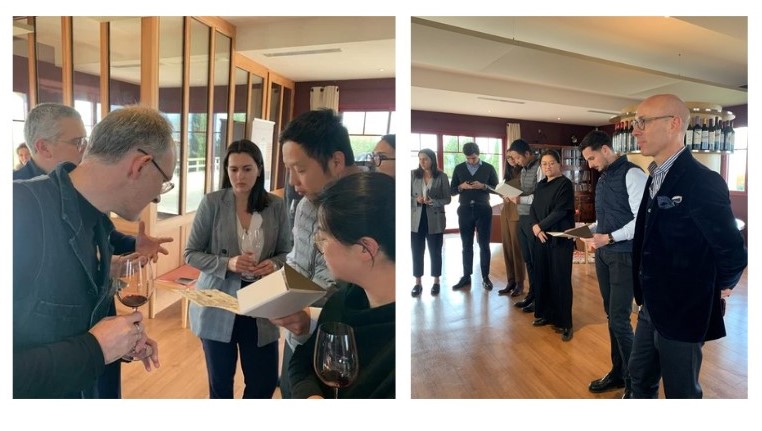
G: We have decanted the wine 2 hours before the tasting. It is lovely to drink now, but it can age also many, many years more to me. What do you think?
CH: Yes, absolutely. That hint of truffle and of graphite turning to cedar hint at what will be revealed with more aging. This, for me, has fabulous aging potential. 30 to 40 years.
G: So long?
CH: Yes, absolutely. But this is very much a matter of taste. I’m not saying that the wine should be held that long nor even that it will necessarily become better over that period of time. Actually, I rather like the wine as it is now. But it’s also a wine I want to see evolve, tasting it intermittently, to see above all the development in its aromatic profile. The structure will remain very intense and very intact, I think.
G: We go now back 8 years, with La Chapelle d’Ausone 2011 . This vintage was for me one of the most difficult En Primeur tastings, I have ever done in my career because of the tannin structure in the wines. This 2011 La Chapelle was for me great as well, but perhaps a little more ‘old-fashioned’ in style.
CH: I have very much the same view as you. The style here is related to the character of the vintage. Even with what is Ausone’s second wine, we have a wine that has only recently and eventually begun to soften. That is very much a characteristic of 2011. As a vintage, from en primeur onwards it was a brutal tannic, monster, like a block of concrete, in the Médoc as much as in Pomerol and Saint Emilion. Now, eventually, those tannins are starting to resolve themselves. What we have here is very interesting in the mouth. It is quite supple, tender and luxurious on the attack, but somewhere in the mid-palate and more and more towards the finish those 2011 tannins start to kick in and engage, reminding us of the vintage that formed them. They still have a way to go to fully resolve themselves. It’s almost like seeing a block of limestone being carved into a beautiful sculpture in real time! The head and shoulders of the statue are already beautifully formed, but the chest remains ensnared in the uncut rock. We can see the direction in the wine is going but it is not yet finished. That said, this is and will be a very beautiful expression of Chapelle. I love it aromatically. It has a sort of bulby florality. Like a peony bulb, with the full potential of the bloom still held within it. You have the feeling that we are still at an early stage. You have some of Ausone’s black cherries as well. It is a great wine and it is fascinating to taste it at this point. But it deserves to be held just a little bit longer.
G: We concluded with an exceptional Ausone 2010. For me, one definition of an exceptional wine is a wine that is alive and constantly evolving in the glass.
CH: Yes, indeed this is fabulous and the highlight of this tasting. There are all kind of things you can say about it. And, as you say, whatever you might be tempted to say about it now, you might need to revise half an hour or an hour later! The wine was decanted two hours before the tasting, but it opens up massively in the glass too. There is 55% Cabernet Franc here, which is quite representative for Ausone. The wine has an incredible density and intensity. It has a very compact and very spherical mid-palate. This is a beautifully soft and beguiling wine. Even though there are a lot of tannins, they are already very finely resolved, exuding finesse and with the most delicate fine graining. There is no angularity, but plenty of grip and lots of tactile texture. The other thing which is very pleasing here and which is also very “Ausone” is the sense of tension between the amplitude the wine wants to take, pushing out towards the cheeks, and the structuring tannins that draw the fruit back to the spine. That increases the impression of density and reminds us of the limestone terroir. For it is only limestone tannins that can sculpt a wine in this way. What I love as well is that the tannins are so fine grained that it gives a glassiness to the plunge-pool mid-palate. This I find beautifully shimmering in the mouth, utterly gorgeous and very special. It will continue to evolve for decades. The other thing that I really like here also relates to the limestone terroir. It is the pinch of the tannins just towards the finish. The effect is to gather up the fruit building a little wave of sapid freshness that sustains the wine to the distant horizon, with a little saline hint bringing additional complexity
G: In the interview we had 3 years ago, you said “a perfect wine gives me almost an emotional feeling”. Was this also the case with this Ausone 2010.
CH: Oh yes absolutely! Emotional and physical – I have goose pimples all over! You are in the presence of something which is rare and exceptional for a wine lover like me. It is not about what it is, but just what it feels like in your mouth. It is always a privilege to experience greatness and my reaction to such greatness is increasingly emotional.
The Summary: The Vauthier Style 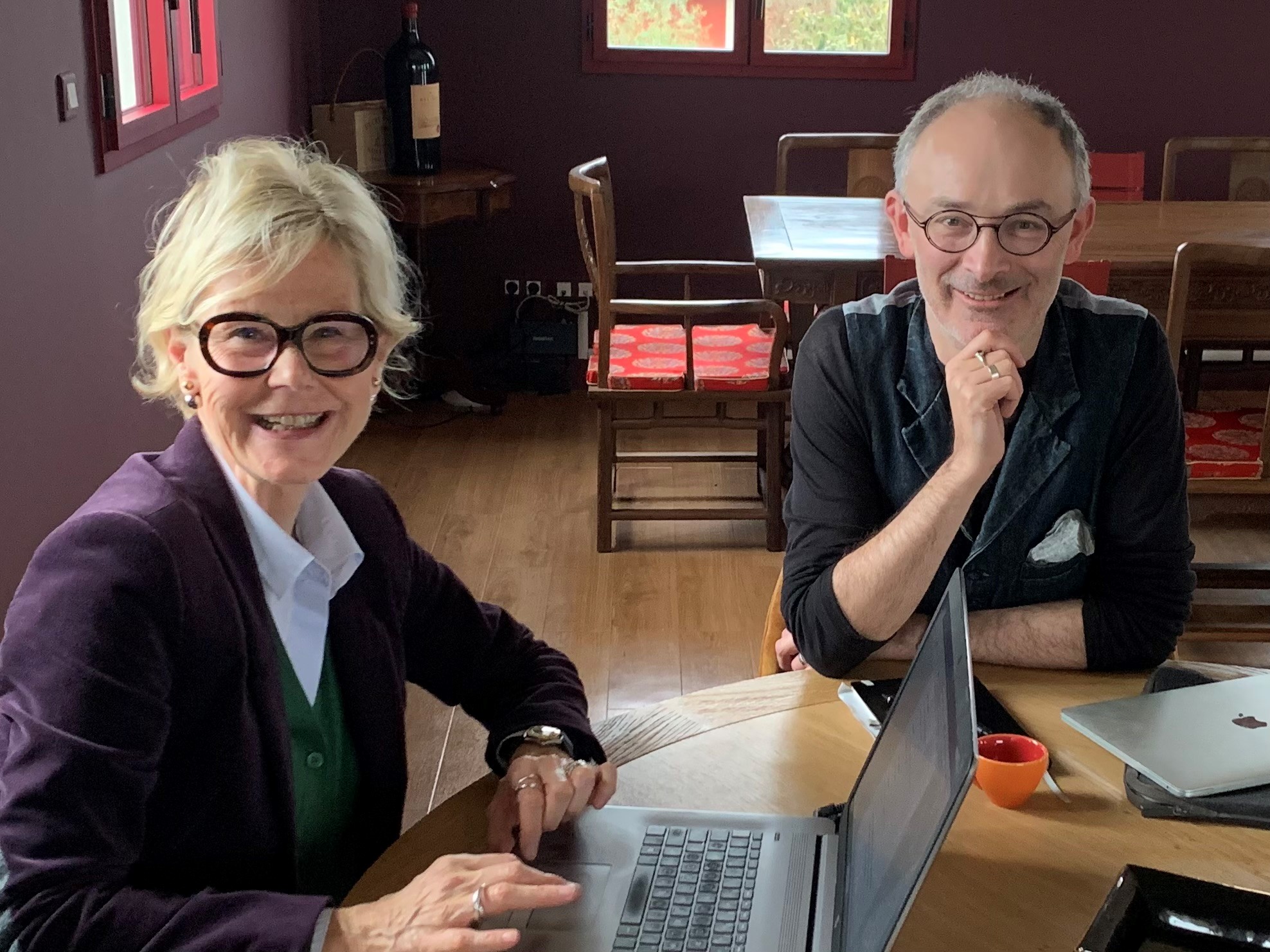
Colin Hay highlights a distinctive Vauthier style, characterized by:
Respect for and expressive of the Saint-Émilion terroir
A progression of wines reflecting the different terroirs, from the slopes to the limestone plateau
A purity of fruit and refined tannic structure
Brightness and crystalline clarity in the wines
Colin Hay summarizes : “The Vauthier style is about expressing the terroir within the context of the vintage”.

Gerda BEZIADE has an incredible passion for wine, and possesses a perfect knowledge of Bordeaux acquired within prestigious wine merchants for 25 years. Gerda joins Roland Coiffe & Associés in order to bring you, through “Inside La PLACE” more information about the estate we sell.

